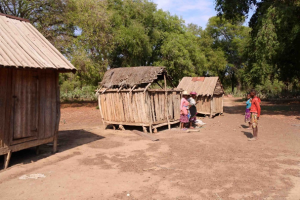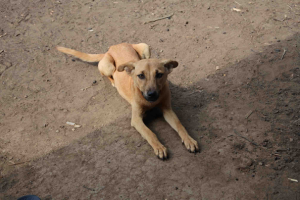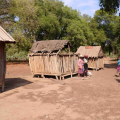
2016 Activity Report
Long-term field studies and biodiversity conservation
in protected forests of Madagascar
Shinichiro ICHINO
Post-doctoral researcher, Center for African Area Studies
Kyoto University
- Research themes
Conservation of biodiversity in the African tropical forest has come to be considered a global environmental issue. Madagascar has unique flora and fauna with high rates of endemism. In spite of the uniqueness, it is estimated that more than 90% of natural forest of Madagascar has disappeared and most animals and plants are facing a high risk of extinction. Thus, Madagascar is considered to be one of the biodiversity hotspots where high-priority conservation efforts are required.
Despite the current expansion of Madagascar’s protected forest areas, the most forests already have been fragmented and only small forest fragments still remain in some area of Madagascar. In such area, conserving the remaining small forests as many as possible is more realistic conservation strategy to achieve high biodiversity as a whole. Although small forest has risk of extinction of some specific taxa, it has also some advantages that management can protect the forest strictly and react quickly to any situation. In order to achieve biodiversity conservation by the remaining small forests, it is required to clarify the potential risk and the potential value of small forests in the area.
In this study, I focus on relations between long-term field research and biodiversity conservation. In field primatology and field ecology, long-term field studies have been conducted in several research sites in Madagascar and the activity is expected to contribute to biodiversity conservation in the area. In spite of such expectation, we still have not clarified what kind of activities and scientific findings by the long-term field research contribute to biodiversity conservation in the area. Thus, clarification of the relations and the background situation in each research site may help to understand the way to enhance values of small forest for biodiversity conservation.
I examine cases of the following three Malagasy forests where long-term field studies for more than 20 years have been conducted and clarify the roles and the problems of the long-term field study and other related activities on biodiversity conservation of the forests.
1) Berenty Reserve (Southern Madagascar, semi-deciduous gallery forest)
2) Ankarafantsika National Park (Northwestern Madagascar, deciduous dry forest)
3) Kirindy Forest (Southwestern Madagascar, deciduous dry forest)
- Dispatch details
Madagascar (August 29 – November 28, 2016)
I visited my main study site, Berenty Reserve and collected information on the management of the reserve. I also conducted behavioral observation of lemurs, a survey of plants and animals in the reserve, and a field interview survey on local knowledge on plants and animals. I also visited Ankarafantsika National Park in northwestern Madagascar and observed the study site and the field station for researchers.
- Particularly noteworthy professional and personal experiences during my dispatch
I stayed at the Berenty Reserve from September to the middle of November, the late dry season. During my stay in the reserve, birds and reptiles were very active and I could directly observe many species. The degree of classification of forest vertebrates by the local people was highly different between taxa, probably because of differences of the opportunity of observation and the degree of interest in the animal. For example, tenrecs and most birds are considered as food item and snakes and chameleons are considered as dangerous animals by the local people. They have detailed classification of such animals and mentioned detailed characteristics of the species. On the other hand, their classification of small skinks, frogs, rats, carnivores and nocturnal lemurs was unclear.
I visited a village which is located on the opposite shore of the Mandrare River and observed the village and the forest (Photo 1). There are many tamarind (Tamarindus indica) trees, the most important food species for lemurs and I could observe some ring-tailed lemurs (Lemur catta) in the village. According to the local people, ring-tailed lemurs and Verreaux’s sifaka (Propithecus verreauxi) often visit the village. These lemurs may be able to survive in artificial forest near village.
I conducted a preliminary investigation of nocturnal animals in the reserve using automatic infrared sensor cameras with Ms. Ayani, a graduate student and Dr. Sato. The small indian civet (Viverricula indica), the cat, and the dog were recorded in the camera. The camera records showed that at least 3 dogs inhabited the small forest and they were active both in day and night. More detailed studies on the effects of dogs (Photo. 2) on wildlife communities of the reserve are required.
- Achievement of research objectives and areas needing improvement
I visited the Faculty of Science at the University of Antananarivo and had a meeting with Prof. Rakotomanana, a main collaborative researcher and Prof. Rakotondraparany. We could talk about new collaborative research project and Memorandum of Understanding with our Center.
I made a list of forest vertebrates of Berenty Reserve including information on the local knowledge. I am preparing a manuscript for the report. On the other hand, a list of invertebrates and plants of Berenty Reserve is not completed yet because of huge number of species.
Photo 1. A village on the opposite shore of the Mandrare River
Photo 2. A dog in southern Madagascar
- Challenges and objectives for the next dispatch
I will start new collaborative research project with a graduate student of the University of Antananarivo on the next visit to Madagascar. Also I will talk with collaborative researchers for implementation of the Memorandum of Understanding with our Center then.











